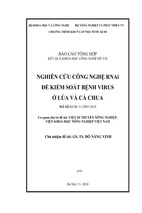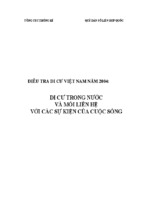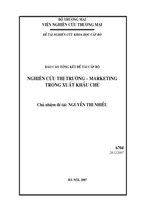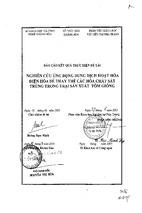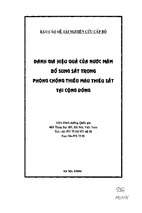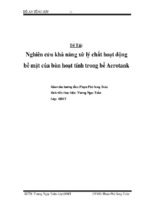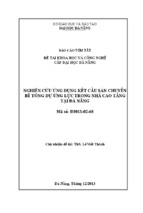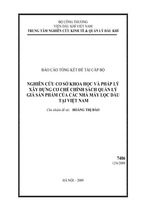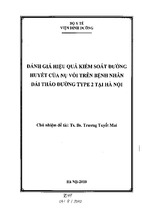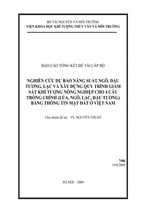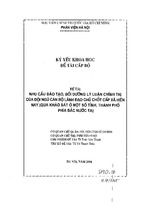Proteomic analysis of the response of murine bone
marrow derived macrophages to IFN-γ stimulation
and infection with Staphylococcus aureus
Inauguraldissertation
zur
Erlangung des akademischen Grades
Doktor rerum naturalium (Dr. rer. nat.)
die Mathematisch-Naturwissenschaftliche Fakultät
der Ernst-Moritz-Arndt-Universität Greifswald
Vorgelegt von Dinh
Hoang Dang Khoa
geboren am 12.06.1981
in Binh Thuan - Vietnam
Greifswald, July 2010
i
Dekan: .........................................................................................................................................
1. Gutachter 1: .............................................................................................................................
2. Gutachter 2: ..............................................................................................................................
Tag der Promotion:.......................................................................................................................
......................................................................................................................................................
ii
Content
Abbreviations ...................................................................................................................................i
List of Figures and Tables ........................................................................................................... iii
Summary ......................................................................................................................................... 1
1. Introduction ............................................................................................................................... 3
1.1. Macrophages......................................................................................................................... 3
1.1.1. Macrophage origin and morphology ...................................................................... 3
1.1.2. Immunological function of macrophages ............................................................... 3
1.1.2.1. Microbial pathogen phagocytosis ................................................................. 4
1.1.2.2. Antigen presentation ..................................................................................... 5
1.1.2.3. Immune modulation ...................................................................................... 5
1.1.3. Other functions of macrophages ............................................................................ 6
1.2. IFN gamma activation of macrophages ................................................................................ 7
1.2.1. IFN gamma ............................................................................................................. 7
1.2.2. Effects of IFN-γ on macrophages ........................................................................... 7
1.3. Proteomics studies of macrophages ...................................................................................... 9
1.3.1. Strategies of proteomics analysis ........................................................................... 9
1.3.2. Macrophage proteomics ....................................................................................... 11
1.4. Interaction of Staphylococcus aureus and macrophages .................................................... 12
1.5. A reproducible experimental system - Bone marrow derived macrophages in serum-free
culture ............................................................................................................................................ 14
2. Materials and Methods ........................................................................................................... 15
2.1. Materials ............................................................................................................................. 15
2.1.1. Chemicals ............................................................................................................. 15
2.1.2. Instruments ........................................................................................................... 16
2.1.3. Software ............................................................................................................... 17
2.2. Methods .............................................................................................................................. 17
2.2.1. Sample preparation ............................................................................................... 17
2.2.1.1. Stem cell preparation, cultivation, and differentiation to macrophages .... 17
2.2.1.2. Interferon-γ activation of bone marrow derived macrophages .................. 18
iii
2.2.1.3. S. aureus infection....................................................................................... 18
2.2.1.4. BMM protein extraction for proteome analysis .......................................... 19
2.2.1.5. Determination of protein concentration ..................................................... 19
2.2.2. 2D-DIGE approach .............................................................................................. 19
2.2.2.1. CyDye labeling reaction for DIGE experiment .......................................... 19
2.2.2.2. Rehydration ................................................................................................. 20
2.2.2.3. IEF separation ............................................................................................ 20
2.2.2.4. Equilibration ............................................................................................... 21
2.2.2.5. Second dimension separation ..................................................................... 21
2.2.3. Protein spot visualization ..................................................................................... 21
2.2.3.1. CyDye DIGE scanning ................................................................................ 21
2.2.3.2. Colloidal coomassie staining ...................................................................... 22
2.2.4. Spot detection and quantification ......................................................................... 22
2.2.5. Mass spectrometry analysis .................................................................................. 23
2.2.5.1. MALDI-TOF-MS/MS .................................................................................. 23
2.2.5.1.1. Preparative gels ................................................................................................ 23
2.2.5.1.2. Protein identification by MALDI-TOF/TOF MS .............................................. 23
2.2.5.2. Quantitative LC-MS/MS analysis ............................................................... 24
2.2.6. Functional classification of proteins .................................................................... 26
2.2.7. Transcriptomic analysis ........................................................................................ 26
3. Results ....................................................................................................................................... 28
3.1. 2-DE protein reference map of BMMs ............................................................................... 30
3.2. IFN-γ effect on BALB/c and C57BL/6 macrophages ........................................................ 36
3.2.1. IFN-γ regulated proteins identified by 2D-DIGE technique ................................ 37
3.2.2. IFN-γ regulated proteins identified by LC-MS/MS and comparison with
transcriptomic results. ............................................................................................................... 45
3.3. Comparative proteome analysis of BALB/c and C57BL/6 macrophages ..............................
............................................................................................................................................ 59
3.3.1. Differences in proteomic profiles of BMM-BALB/c and BMM-C57BL/6
identified with the 2D – DIGE technique ................................................................................. 60
3.3.2. Comparison of LC-MS/MS and transcriptomic data ........................................... 64
iv
3.4. Effects of S. aureus infection on the proteome pattern of IFN-γ stimulated BMMC57BL/6 ......................................................................................................................................... 70
4. Discussion ................................................................................................................................. 79
4.1. 2-DE proteome reference map of bone marrow derived macrophages .............................. 79
4.2. IFN-γ effects on BMM-BALB/c and BMM-C57BL/6 identified by proteomic 2D-DIGE
and LC-MS/MS approaches ........................................................................................................... 80
4.2.1. Transcription regulation ....................................................................................... 81
4.2.2. p47 and p65 GTPases ........................................................................................... 82
4.2.3. Antigen presentation ............................................................................................ 83
4.2.4. Metabolism ........................................................................................................... 85
4.2.5. Cell survival ......................................................................................................... 86
4.2.6. Secretion of cathepsin L and metalloelastase ....................................................... 87
4.2.7. Well known, immunologically important proteins not influenced by IFN-γ
treatment .............................................................................................................................. 88
4.3. Changes in the proteome of IFN-γ stimulated BMM-C57BL/6 due to S. aureus infection ...
............................................................................................................................................ 88
4.3.1. Anti-microbial proteins ........................................................................................ 88
4.3.2. Inflammatory regulation proteins ......................................................................... 89
4.3.3. Cell-cell interaction .............................................................................................. 91
4.3.4. Metabolism ........................................................................................................... 91
4.3.4.1. Protein and glucose uptake......................................................................... 91
4.3.4.2. Lipid metabolism......................................................................................... 92
4.3.4.3. Cellular iron homeostasis ........................................................................... 92
4.3.5. Immune-responsive gene 1 protein ...................................................................... 94
4.4. Differences in proteome of BMMs derived from strain BALB/c and C57BL/6 ................ 94
Conclusion ..................................................................................................................................... 96
References ..................................................................................................................................... 97
Affidavit
Curriculum Vitae
Acknowledgments
Supplements
v
Abbreviations
2-DE
: Two dimensional gel electrophoresis
2D-DIGE
: Two-dimensional difference gel electrophoresis
ACN
: Acetonitrile
APS
: Ammonium persulphate
BMM
: Bone marrow derived macrophages
CD
: Cluster of differentiation
CyDye
: CyDye DIGE fluorescent dyes
Da
: Dalton
DCs
: Dendritic cells
DIGE
: Fluorescence difference gel electrophoresis
DNA
: Deoxyribonucleic acid
DTT
: Dithiothreitol
ER
: Endoplasmic reticulum
FBS
: Fetal bovine serum
FCS
: Fetal calf serum
Fig.
: Figure
HPLC
: High performance liquid chromatography
IAA
: Iodoacetamide
ID(s)
: Identifier(s)
IEF
: Isoelectric focusing
IFNGR
: Interferon gamma receptor
IFN-γ
: Interferon gamma
IL
Interleukin
iNOS
: Inducible nitric oxide synthase
IPG
: Immobilized pH gradient
IPI
: International Protein Index
kDa
: Kilodalton
i
LC
: Liquid chromatography
LC-MS/MS
: Liquid Chromatography-Tandem Mass Spectrometry
LPS
: Lipopolysaccharide
MALDI
: Matrix-assisted laser desorption/ionization
MHC
: Major histocompatibility complex
min
: Minute
Mr
: Molecular mass
mRNA
: Messenger ribonucleic acid
MS
: Mass spectrometry
MS/MS
: Tandem mass spectrometry
NADPH
: Nicotinamide adenine dinucleotide phosphate
NCBI
: National Center for Biotechnology Information
NK
: Natural killer cell
NO
: Nitric oxide
NOS
: Nitric oxide synthase
PANTHER
: Protein Analysis Through Evolutionary Relationships
PBS
: Phosphate buffered saline
PCA
: Principal components analysis
pI
: Isoelectric point
PTM
: Post-translational modification
RNA
: Ribonucleic acid
RNI
: Reactive nitrogen intermediate
ROI
: Reactive oxygen intermediate
ROS
: Reactive oxygen species
S. aureus
: Staphylococcus aureus
SDS
: Sodium dodecyl sulphate
SDS-PAGE
: Sodium dodecyl sulfate polyacrylamide gel electrophoresis
STAT
: Signal transducer and activator of transcription
Suppl.
: Supplements
TBS
: TRIS-buffered saline
ii
TEMED
: N,N,N',N'-tetramethylethylenediamine
TGF-β
: Transforming growth factor beta
TH
: T helper cell
TLR
: Toll-like receptor
TNF
: Tumor necrosis factor
Tris
: Tris(hydroxymethyl) aminomethane
vs.
: versus
List of Figures and Tables
Figures
Figure 1: Typical appearance of macrophage ............................................................................................... 4
Figure 2: Overiew of BMMs proteomics and transcriptomics analyses...................................................... 29
Figure 3: Molecular mass – isoelectric point plot ....................................................................................... 32
Figure 4: 2-DE proteome reference map of BMMs .................................................................................... 33
Figure 5: Functional classification of identified proteins on 2-DE proteomic reference map .................... 34
Figure 6: 2D-DIGE experiment scheme ...................................................................................................... 38
Figure 7: Representative gel image of the IFN-γ effects on proteome of BMM-BALB/c .......................... 40
Figure 8: Representative gel image of the IFN-γ effects on proteome of BMM-C57BL/6......................... 41
Figure 9: Induction of cathepsin B and cathepsin S protein isoforms due to IFN-γ stimulation................. 44
Figure 10: Principal component analysis of proteomic LC-MS/MS and transcriptomic data..................... 47
Figure 11: Ratio plot of identified IFN-γ regulated genes and proteins ...................................................... 50
Figure 12: Functional classification of IFN-γ regulated proteins and genes identified by proteomic LCMS/MS and transcriptomic technique ..................................................................................................... 52
Figure 13: Overlay between identified genes and proteins. ........................................................................ 53
Figure 14: mRNA and protein level of thirdteen immune related genes ..................................................... 55
Figure 15: Representative gels of differences in 2-DE protein expression profiles of BMM-BALB/c and
BMM-C57BL/6 ....................................................................................................................................... 61
Figure 16: Different distribution of protein isoforms of BGLR and ERP29 in BMM-BALB/c and BMMC57BL/6 .................................................................................................................................................. 63
Figure 17: Ratio plot of mRNAs and proteins being present at different levels in a strain-dependent
manner ..................................................................................................................................................... 66
Figure 18: Functional classification and cellular localization of the 343 proteins identified as different
levels in BMM-BALB/c and BMM-C57BL/6 ........................................................................................ 69
Figure 19: Experimental setting for identifying IFN-γ effects and S. aureus effects in BMM-C57BL/6 ... 71
iii
Figure 20: Mapping of IFN-γ regulated genes/proteins and S. aureus regulated proteins in
BMM-C57BL/6 ....................................................................................................................................... 73
Figure 21: Functional classification of S. aureus regulated proteins .......................................................... 76
Figure 22: Time-resolved analysis of the intensity changes of some selected proteins influenced by
infection with S. aureus ........................................................................................................................... 78
Tables
Table 1: BMM batches used in the study .................................................................................................... 18
Table 2: The serial dilution of BSA-standard solution ............................................................................... 19
Table 3: IEF program for Immobiline DryStrip pH 4-7, 24 cm .................................................................. 21
Table 4: Protein distribution on 2D proteomic reference map .................................................................... 31
Table 5: IFN-γ modulated protein spots in BMM-BALB/c and BMM-C57BL/6 identified by the 2D-DIGE
technique ................................................................................................................................................. 39
Table 6: Proteins identified in IFN-γ modulated protein spots.................................................................... 43
Table 7: Summary of genes and proteins identified by transcriptomic and proteomic LC-MS/MS technique
as IFN-γ regulated ................................................................................................................................... 48
Table 8: Overlay of genes and proteins influenced by IFN-γ treatment...................................................... 54
Table 9: Functions of immune related genes for which total mRNA and protein amount were not
influenced by IFN-γ stimulation.............................................................................................................. 55
Table 10: List of a total of 69 IFN-γ regulated proteins in BMM-BALB/c and/or BMM-C57BL/6
identified by LC-MS/MS technique ........................................................................................................ 56
Table 11: Twenty seven genes for which changes by IFN-γ stimulation were observed at both
transcriptional and translational level ...................................................................................................... 58
Table 12: Immune related proteins which were not changed in total amount due to IFN-γ stimulation .... 58
Table 13: Protein spots identified by 2D-DIGE technique and displaying strain-specific differences in
intensity ................................................................................................................................................... 60
Table 14: Summary of genes and proteins displaying strain specific expression levels identified by
transcriptomics and LC-MS/MS techniques ........................................................................................... 65
Table 15: Overlay of genes and proteins showing different expression or levels ....................................... 67
Table 16: Proteins regulated by infection with S. aureus in IFN-γ stimulated BMM-C57BL/6 ................. 72
Table 17: Proteins influenced in abundance by infection with S. aureus at 6 h and/or 24 h post infection 74
Table 18: Proteins influenced in abundance by infection with S. aureus and IFN-γ stimulation ............... 75
iv
Summary
Dissertation
Summary
Macrophages which are distributed throughout the normal body provide the first line of
defence against microbial pathogen infections. With vigorous phagocytosis ability, macrophages
can eliminate a wide variety of invading microorganisms including viruses, bacteria, fungi and
protozoa. Macrophages also function as professional antigen presenting cells which connect
innate and adaptive arms of the immune system. Moreover, many secreted cytokines from
macrophages are involved in modulation of the immune response. IFN-γ is well known as a main
macrophage stimulator. IFN-γ stimulated macrophages possess higher bactericidal capacity than
in normal state. Many physiological and functional changes in IFN-γ stimulated macrophages
were reported such as inducing in production of reactive oxygen species (ROI), nitric oxide
(NO), and secretion of pro-inflammatory cytokines. However, information about the changes in
the proteome of macrophages upon activation by IFN-γ is still limited.
Murine bone marrow derived macrophages (BMMs) are a good model for investigating
macrophage biology. In this study, murine BMMs were generated from a well defined
standardized serum-free culture system which ensures in comparison to established serumcultivation improved reproducibility and accuracy of the results. Effects of stimulation with IFNγ on the proteome of BMMs from an infection-susceptible mouse strain BALB/c and a resistance
mouse strain C57BL/6 were studied by complementary 2D-DIGE (gel-based) and LC-MS/MS
(gel-free) approaches.
A 2-DE proteome reference map of BMMs was created from protein pools of BMMBALB/c and BMM-C57BL/6 proteins via 2-DE electrophoresis and MALDI-TOF/TOF-MS. This
reference map covers 252 identified protein spots of 145 unique proteins. Functional analysis
showed that “protein metabolism and modification”, “immunity and defense”, “cell structure and
motility” were the most abundant biological functional groups among the identified proteins.
Applying the 2D-DIGE technique, we identified 18 and 19 proteins spots, respectively, for
which spot intensities were significantly changed in BMM-BALB/c and BMM-C57BL/6 due to
IFN-γ stimulation. While LC-MS/MS analysis revealed 45 and 53 IFN-γ affected proteins,
respectively, in BMM-BALB/c and BMM-C57BL/6. Interestingly, results of the two proteomics
analyses showed that BMMs derived from susceptible strain BALB/c and resistance strain
C57BL/6 responded to IFN-γ stimulation with a consistent pattern. The functions of the identified
IFN-γ regulated proteins could be assigned to transcription regulation (STAT1), microbicidal
activity (members of p47 and p65 GTPases), antigen presentation (components of MHC class I
and class II molecule, TAP2, lysosomal cathepsins), cell survival (PRDX4, NAMPT, AIF-1), and
metabolism (hexokinases, ACSL1).
1
Summary
Dissertation
The activation of macrophage is believed to be a two step process [1]: the first step requires
a priming signal (prototypically IFN-γ) which, though capable of inducing a number of changes,
is insufficient to endow the responding cell with full functional competence. Exposure to the
second triggering signal (lipopolysaccharide, for example) is sufficient to complete the functional
activation process.
For obtaining an overview of the macrophage activating process, we
designed experiments to gain information about changes in the proteome of macrophages in each
of the two steps of activation. IFN-γ activated BMM-C57BL/6 were allowed to internalize
Staphylococcus aureus and changes in the proteome were analyzed 6 h and 24 h after exposure of
BMMs to S. aureus. With an LC-MS/MS approach, 13 and 45 proteins of IFN-γ activated BMMC57BL/6 were found to change in amount at the two time points (6 h and 24 h) after S. aureus
infection, respectively. Functional analysis showed that the proteins displaying changes in
intensity upon interaction with S. aureus are involved in microbicidal activity (NOS2, OAS1A,
GBP5), inflammation regulation (PTGS2, IL1B, CAV1, SQSTM1), cell-cell interaction (CD14),
protein and glucose uptake (SLC7A2, SLC3A2, SLC2A1), lipid metabolism (ACSL1, LPL), and
cellular iron homeostasis (FTH1, ACO2, HMOX1, ALAS1). Interestingly, we have observed that
stimulation with IFN-γ and interaction with S. aureus mostly targeted different sets of proteins,
while synergistic effect were observed for seven proteins which were regulated by both factors.
In general, mice of the strain C57BL/6 are more resistance to microbial infection than mice
of the strain BALB/c. Moreover, BMM-C57BL/6 were reported to possess a higher capacity of
killing B. speudomallei in comparison with BMM-BALB/c [2]. Therefore, the differences in the
proteome and transcriptome of BMMs derived from susceptible BALB/c and resistant C57BL/6
mice may be related to the differences in bactericidal capacity. Surprisingly, while many
differences between BMM-BALB/c and BMM-C57BL/6 were found at the protein level, only
few differences were observed at the mRNA level. At the protein level, 168 and 204 out of total
914 proteins spots (2D-DIGE analysis); 218 and 308 out of total 946 proteins (LC-MS/MS
analysis) were found to be present at different levels in BMM-BALB/c and BMM-C57BL/6 nonstimulated or after IFN-γ treatment, respectively. While at mRNA level, the corresponding
numbers of genes differentially expressed between non-stimulated and IFN-γ treated BMMs were
222 and 230 out of 20,074 genes, respectively. The differences between proteomic and
transcriptomic data may due to different post-transcriptional mRNA processing, translational
regulation and post translational modification (PTM) activities in BMM-BALB/c and BMMC57BL/6. Interestingly, cellular location analysis showed that most of proteins which were more
abundant in BMM-C57BL/6 were located in mitochondria and the lysosome, two cellular
compartments important for immunological function of macrophages.
2
Introduction
Dissertation
1. Introduction
1.1. Macrophages
1.1.1. Macrophage origin and morphology
Macrophages are distributed throughout the normal body and display regional
heterogeneity [3]. They can be found in lung (alveolar macrophages), liver (kupffer cells), spleen
(red pulp macrophages), skin (langerhans cells), and intestine. Macrophages differentiate from
circulating peripheral blood mononuclear cells, which migrate into tissue in the steady state or in
response to inflammation. These peripheral blood mononuclear cells develop from a common
myeloid progenitor cell in the bone marrow that is the precursor of many different cell types,
including neutrophils, eosinophils, basophils, macrophages, dendritic cells and mast cells. During
monocyte development, myeloid progenitor cells (termed granulocyte/macrophage colonyforming units) sequentially give rise to monoblasts, pro-monocytes and finally monocytes, which
are released from the bone marrow into the bloodstream [4].
Macrophages are generally large, irregularly shaped cells measuring 25-50 µm in diameter.
Electron microscopy demonstrates an eccentric nucleus of variable shape, with chromatin
disposed in fine clumps. Clear spaces between membrane-fixed chromatin clumps mark the site
of nuclear pores. The cytoplasm contains scattered strands of rough endoplasmic reticulum, a
well-developed Golgi complex in a juxtanuclear position, variable number of vesicles, vacuoles
and pinocytic vesicles, large mitochondria and electron dense membrane bound lysosomes which
can be seen fusing with phagosomes to form secondary lysosomes. Within the secondary
lysosomes, ingested cellular, bacterial and non-cellular material can be seen in various stages of
degradation and digestion. Microtubules and microfilaments are prominent in macrophages and
form a well-organized, three-dimensional cytokeleton which surrounds the nucleus and extends
throughout the cytoplasm to the cell periphery [5].
1.1.2. Immunological function of macrophages
Microbial pathogens must breach normal host defences to establish invasive infections.
With vigorous phagocytic ability, macrophages function as the first line of defense to eliminate
the invaders and to maintain sterility of deep tissues. Moreover, through antigen presentation
function, macrophages are key regulators of the immune system connecting innate and specific
3
Introduction
Dissertation
immune responses. They also participate in the activation of T and B lymphocytes through the
secretion of many cytokines.
Figure 1: Typical appearance of macrophage. The cell surface exhibits many membrane extensions.
The cytoplasm contains some dense granules corresponding to lysosomes. The Golgi apparatus is well
developed. The nucleus presents its typical lobate shape and a rather thick layer of dense chromatin along
its membrane (12,000 x) [6].
1.1.2.1. Microbial pathogen phagocytosis
The central feature of macrophages is the ability to eliminate free or opsonized invading
microorganisms through phagocytosis. In viral infection, mononuclear phagocytes (blood
monocytes, tissue macrophages, and dendritic cells) have the ability to engulf and eliminate virus
from the circulation following a blood-borne infection. Their scavenger function constitutes a
first line of defence that reduces the virus load until specific immune responses become available
[7]. Phagocytosis and bacterial killing are functions for which macrophages are well suited. They
ingest potential pathogens via an array of non-opsonic and opsonic receptors and kill their prey
with the oxygen-dependent and oxygen independent mechanisms. In oxygen-dependent
mechanisms, macrophages produce reactive oxygen intermediates (ROIs) such as superoxide (O2), hydrogen peroxide (H2O2) and hydroxyl radicals (OH.). ROIs are microbicidal by virtue of the
damage they cause to bacterial DNA and membranes [8].
In the second mechanism,
macrophages may destroy pathogen with reactive nitrogen intermediates (RNIs), defensins, and
lysosomal degradative enzymes [9]. The digested microorganism derived antigens are then
4
Introduction
Dissertation
presented to T-cells in regional lymph nodes for initiation of specific immune responses that
subsequently clear the infection.
1.1.2.2. Antigen presentation
The professional antigen presentating cells include macrophages, langerhans cells, dendritic
cells and B lymphocytes [10]. Macrophages take up, process and present antigen for lymphocyte
recognition involving both major histocompatibility complex (MHC) class I and class II
pathways. Through that, they present antigen to surveillance CD8+ and CD4+ T cells creating the
initial communication between the innate and acquired arms of the immune system. In general,
antigens in the class I pathway originate from cytosolic proteins and antigens in the class II
pathway originate in lysosomes. After viral infection of macrophages, viral antigens are
processed in the cytosol, transported into the endoplasmic reticulum and presented on the surface
of macrophages in association with MHC class I molecules. Binding between receptors of CD8+
T cells and antigen-MHC class I molecule complexes usually results in stimulation of cytotoxic
effector mechanism. Antigen-MHC class II molecule complexes are recognized by CD4+ T cells.
Activation of CD4+ T cells can initiate a T helper cell response, B-cell activation, and
immunoglobulin secretion [11].
1.1.2.3. Immune modulation
It has become apparent that mononuclear phagocytes, in addition to their phagocytic and
immune-modulating properties, have an extensive secretory capacity that includes secretion not
only of enzymes but of many other biologically active substances. Over 100 substances have
been reported to be secreted by mononuclear phagocytes, with molecular mass ranging from 32
Da (superoxide anions) to 440 000 Da (fibronectin), and biological activity ranging from cell
growth to cell death. They are enzymes, enzyme inhibitors, complement components, reactive
oxygen intermediates, arachidonic acid intermediates, coagulation factors, and cytokines [1, 12].
Macrophages are known to produce IFN-α in response to viruses, bacteria, and tumor cells. The
biological actions of IFN-α include antiviral and antimitotic effects, up-regulation of MHC class
II expression, and an increase in natural killer cell activity. Once induced, IFN-α can restrict viral
replication in infected macrophages as well as in neighbouring cells [13].
5
Introduction
Dissertation
Monocytes, together with many other cells, produce interleukin 1 (IL-1), which is involved in
immunoregulation, influencing IL-2, IL-4, IL-6, IL-1 and tumor necrosis factor alpha (TNF-α)
production [14]. IL-1 represents a family of polypeptides with a wide range of biological
activities including augmentation of cellular immune responses (T-, B-, and NK cells),
proliferation of fibroblasts, chemotaxis of monocytes, neutrophils, and lymphocytes; stimulation
of prostaglandin E2, increasing in numbers of peripheral blood neutrophils, and neutrophil
activation [15].
Human monocytes, together with lymphocytes, hepatocytes, endothelial cells, and dermal
fibroblasts, also secrete IL-8 [16]. This cytokine stimulates the chemotaxis of both neutrophils
and T-cells, and inhibits IFN-γ release by human NK cells in vitro [17]. The expression of the IL8 gene in monocytes is regulated by known inflammatory agents, such as LPS, PGE2, IL-1, TNFγ and IFN-γ [18].
1.1.3. Other functions of macrophages
Besides immunological functions, it is now known that macrophages are involved in other
important processes such as tumor cell control, disposal of damaged or senescent red cells,
wound healing and tissue repair. Macrophages infiltrate tumours and lysis of tumour cells by
monocytes and macrophages are thought to be a mechanism of host defence against tumours [19].
Cultured human monocytes have been reported to kill tumour cells when activated with cytokines
and endotoxin [20]. Macrophages phagocytose aged erythrocytes during their circulation through
the spleen. The mechanism whereby macrophages recognize senescent cells is unknown.
Senescent red cells are sequestered in the spleen and their destruction presumably occurs because
of a subtle abnormality detected by splenic macrophages. Once ingested by macrophages, the
erythrocyte is degraded to liberate iron from haem, which is then stored in the protein complexes
and transferred to developing erythroblasts [21]. Macrophages are rapidly recruited to wounds
after injury, where they can synthesize collagenase and elastase, helping to debride the wound
[22, 23]. Macrophages also participate in wound healing and tissue remodeling by releasing
substances that induce fibroblast proliferation and neovascularization and in remodeling bone
through resorption by osteoclasts [24].
6
Introduction
Dissertation
1.2. IFN gamma activation of macrophages
1.2.1. IFN gamma
Interferons were discovered because of their potent antiviral activity [25]. IFN-γ is also
known as type II IFN or immune IFN. In contrast to the large number of type I (α, β and ω) IFN
genes and proteins found in mice and human, there is only one IFN-γ gene and protein. IFN-γ
maps to a single locus located on the long arm of chromosome 12 in the human, and chromosome
10 in the mouse. Mature IFN-γ messenger ribonucleic acid (mRNA) is ~1.2 kb and encodes a
protein of ~17 kDa [26].
IFN-γ is a crucial factor in the clearance of infection as impaired production of IFN-γ or
defects in the IFN-γ signaling pathway result in increased susceptibility to various bacterial [27]
and viral infections [28]. During the innate inflammatory response, IFN-γ is produced mainly by
natural killer cells and subsets of T lymphocytes, including natural killer T cells and CD8+ T cells
[29].
IFN-γ primarily signals through the Jak-Stat pathway, a pathway used by over 50
cytokines, growth factors, and hormones to affect gene regulation. After the binding of IFN-γ to
its receptor, Jak1 and Jak2 are activated and phosphorylate a specific tyrosine residue on the
interferon gamma receptor 1 (IFNGR1) subunit creating a docking site for Stat1. Janus kinases
(Jaks) phosphorylate signal transducer and activator of transcription 1 (Stat1) on tyrosine 701
resulting in the dimerization of Stat1 which then translocates into the nucleus and binds to
specific DNA elements, known as gamma activated sequence, and regulate gene expression [30].
1.2.2. Effects of IFN-γ on macrophages
Macrophage stimulation with IFN-γ induces direct antimicrobial and antitumor
mechanisms as well as up-regulating antigen processing and presentation pathways [31].
One of the most important effects of IFN-γ on macrophages is the activation of
microbicidal effector functions. Macrophages activated by IFN-γ display increased pinocytosis
and receptor mediated phagocytosis as well as enhanced microbial killing ability. IFN-γ-activated
microbicidal ability includes induction of the nicotinamide adenine dinucleotide phosphate
(NADPH)-dependent phagocyte oxidase (NADPH oxidase) system (“respiratory burst”), priming
for nitric oxide (NO) production, tryptophan depletion, and up regulation of lysosomal enzymes
promoting microbe destruction [32].
7
Introduction
Dissertation
Superoxide and its reactive products are important microbicidal effectors of macrophages. The
superoxide anion, O2-, is generated by an enzyme complex known as reduced nicotinamide
adenine dinucleotide phosphate (NADPH) oxidase during a process called “respiratory burst”.
This enzyme is composed of a membrane associated flavocytochrome b559 (a heterodimer
consisting of two subunits, gp91phox and p22phox) concentrated in the phagosome membrane and
four cytosolic components: p47phox, p67phox, p40phox, and the small guanosine triphosphatase
(GTPase) Rac. Upon appropriate stimulus (e.g., phagocytosis), the cytosolic components
translocate to the membrane to form the active complex, which generates superoxide in the
phagosome through transfer of a transported electron to molecular oxygen [33]. The superoxide
anion generated by the “respiratory burst” spontaneously reacts to form hydrogen peroxide
(H2O2), hydroxyl radicals (·OH), and hypochlorous acid (HOCl). The toxic oxidants produced by
the respiratory burst are also able to react with those produced by inducible nitric oxide synthase
(iNOS), thereby forming a large number of different toxic species (e.g., peroxynitrite) to mediate
cytotoxicity by a wide variety of mechanisms [34]. The primary mechanism of IFN-γ induced upregulation of reactive oxygen species (ROS) production in phagocytes is transcriptional induction
of the gp91phox and p67phox subunits of the NADPH oxidase complex [35].
Nitric oxide is produced in the NADPH-dependent conversion of L-arginine to L-citrulline by the
nitric oxide synthase enzymes (NOS1–3). The NOS2/iNOS isoform alone is inducible by
cytokine and/or microbial stimulus. IFN-γ dependent reactive nitrogen intermediate production is
associated with increased ability of phagocytic cells to kill ingested pathogens, while mice in
which the iNOS gene has been mutated show greater susceptibility to viral, bacterial and parasitic
infection. IFN-γ induces RNI production by up-regulating expression of the iNOS enzyme.
Maximal induction of iNOS transcription requires “priming” and “triggering” stimuli such as
priming with IFN-γ and subsequent triggering with LPS or TNF-α [34].
With ability to modulate both cell-mediated immunity mediated by T helper 1 (TH1) cells
and humoral immunity mediated by T helper 2 (TH2) cells, IFN-γ appears as an important
regulator of both innate and adaptive immunity. IFN-γ induces antigen presentation of both MHC
class I and class II pathways in macrophages [27]. Up-regulation of MHC class I antigen
presentation is important for the host response to intracellular pathogens, as it increases the
potential for cytotoxic T cell recognition of foreign peptides and thus promotes the induction of
cell-mediated immunity. IFN-γ was reported to induce expression of MHC class I component.
8
Introduction
Dissertation
Moreover, it also up-regulates the expression of a transporter associated with antigen processing
(TAP) which is vital in peptide transport from the cytosol to the endoplasmic reticulum (ER)
lumen. TAP transiently associates with class I MHC to aid in efficient peptide loading [27]. IFNγ induces a replacement of the constitutive proteasome subunits with “immunoproteasome”
subunits which in turn increase the quantity, quality, and repertoire of peptides for class I MHC
loading [36]. Of the IFNs, IFN-γ alone can efficiently up-regulate the class II antigen presenting
pathway and thus promote peptide-specific activation of CD4+ T cells [27]. IFN-γ treatment
further up-regulates class II MHC molecules in cells constitutively expressing class II MHC, such
as B cells, dendritic cells (DCs), and cells of the monocyte-macrophage lineage [37]. IFN-γ also
up-regulates expression of cathepsins B, H, and L, lysosomal proteases which are implicated in
production of antigenic peptides for class II MHC loading [38, 39].
1.3. Proteomics studies of macrophages
1.3.1. Strategies of proteomics analysis
The term “proteome” was first introduced in the mid-1990s by Wilkins and Williams to
indicate the entire “protein” complement expressed by a “genome” of a cell, tissue, or entire
organism [40]. The proteome of a cell is therefore cell’s specific protein complement in a defined
physiological context at a specific point in time. Instead of focusing on single proteins,
proteomics takes a broader, more comprehensive and systematic approach to the investigation of
biological systems.
Proteomics provides information which that can’t be accessed by genomic techniques. For
example, transcriptomics, a genome-wide measurement of mRNA expression levels, is limited in
the fundamental knowledge of protein expression, stability, and post-translational modifications
in response to biological or physical signals. Moreover, the mRNA level in a cell or tissue does
not necessarily reflect the level of proteins [41]. Often, proteins undergo numerous co- and posttranslational modifications such as proteolysis, phosphorylation, glycosylation, acetylation,
isoprenylation, etc., to reach their functional active form. Interestingly, these modifications
represent an essential source of information that cannot be deduced from the sequence of the
corresponding gene. Therefore, it is now clearly that only proteomics analysis can provide a
comprehensive and quantitative description of the protein pattern and its changes upon perception
of biological or physical signals [42].
9
Introduction
Dissertation
Two main strategies for protein separation and identification which are applied in recent
proteomic studies are gel-fee and gel-based approaches. Two dimensional gel electrophoresis (2DE) which was developed more than 30 year ago [43] remains the most powerful integrated
separation method for proteins. Based on two independent biochemical characteristics of
proteins, 2-DE combines isoelectric focusing, which separates proteins according to their
isoelectric point (pI), and sodium dodecyl sulfate polyacrylamide gel electrophoresis (SDSPAGE), which separates them further according to their molecular mass (Mr). The next typical
steps of the workflow of gel-based proteomics are spot visualization and evaluation, expression
analysis and finally protein identification by mass spectrometry. In conventional gel-based
proteomic workflows, protein visualization was facilitated by post-2-DE staining of gels by
different staining methods such as colloidal coomassie staining and silver staining. Then, the
changes in the protein levels were determined by comparing spot intensities from multiple 2-DE
gels. However, protein spot detection and quantitation might lack accuracy due to the gel to gel
variation and poor reproducibility. Recently, conventional 2-DE has been combined with protein
labeling strategies using up to three different fluorescent dyes to allow comparative analysis of
different protein samples within a single 2-D gel. In this technique, termed differential in-gel
electrophoresis (DIGE), samples are labeled separately then combined and run on the same 2-DE
gel minimizing experimental variation and greatly facilitating spot matching. Furthermore, the
dyes afford great sensitivity with detection down to 125 pg of a single protein, and a linear
response to protein concentration up to five orders of magnitude [44, 45]. However, even with the
2D-DIGE technique there are still some disadvantages such as difficulties in handling
hydrophobic proteins, detecting proteins with extreme molecular mass (Mr) and isoelectric point
(pI) values, as well as limited capability for automation and its labour-intense nature [44].
Non-gel-based quantitative proteomics methods have, therefore, also been developed
significantly in recent years. As opposed to 2-DE, where the samples are separated at the protein
level, most gel-free proteomic approaches are performed at the peptide level. First, the complex
protein mixtures are digested by endopeptidases (usually trypsin) to peptides which are then
separated according to chemical properties (hydrophobicity and charge) by (1D-3D) liquid
chromatography (LC). Then, the eluted peptides can be directly introduced into the mass
spectrometer. Thus, this method has advantages in the generation of automated workflows. In
gel-free LC-based proteomics, protein quantitation is accomplished by stable isotope labelling or
label-free strategies [46, 47].
10
Introduction
Dissertation
Stable isotopes can be introduced in vivo by feeding cells or an entire organism with a medium
enriched with stable isotopes. Alternatively, the isotope can be introduced into the proteins after
extraction from the sample, using a covalent coupling reagent that contains either the natural or
the heavy form of the isotope. By mixing the differently labeled samples before analysis,
experimental procedures can be performed on the mixture of samples. Quantification of changes
in protein concentration is then performed by comparing the signal intensities of peptide ions
containing the stable isotope versus the natural compound [48]. However, most labeling-based
quantification approaches have potential limitations. These include increased time and
complexity of sample preparation, requirement for higher sample concentration, high cost of the
reagents, incomplete labeling, and the requirement for specific quantification software [49, 50].
More recently, high resolution quantitative approaches have been reported that rely on LC-MS
quantitation of peptide concentrations by comparing peak intensities between multiple runs
obtained by continuous detection in MS mode. A characteristic of these comparative LC-MS
procedures is that they do not rely on the use of stable isotopes; therefore the procedure is often
referred to as label-free LC-MS. Major advantages of label-free approaches are that they are
simpler, since no additional chemistry or sample labelling steps are required. Furthermore,
comparative quantification of multiple samples can be performed in one experiment [50, 51]. In
protein-labeling approaches, different protein samples are combined together once labeling is
finished and the pooled mixtures are then taken through the sample preparation step before being
analyzed by a liquid chromatography-tandem mass spectrometry (LC-MS/MS) experiment. In
contrast, in label-free quantitative methods, each sample is separately prepared and then
subjected to individual LC-MS/MS runs. Protein quantification is generally based on two
categories of measurements. In the first are the measurements of ion intensity changes such as
peptide peak areas or peak heights in chromatography. The second is based on the spectral
counting of identified proteins after MS/MS analysis. Peptide peak intensity or spectral count are
measured for individual LC-MS/MS runs and changes in protein abundance are calculated via a
direct comparison between different analyses [50]. It was reported that peak ion intensity
measurements yielding greater accuracy than spectral counting in reporting changes in protein
abundances [52].
1.3.2. Macrophage proteomics
Despite the important roles of macrophages, until now there only some proteomics studies
about this cell type have been reported so far. The first 2-DE maps of the human macrophage
proteome and secretome were recently published. A total of 127 and 66 distinct intracellular and
11
- Xem thêm -



